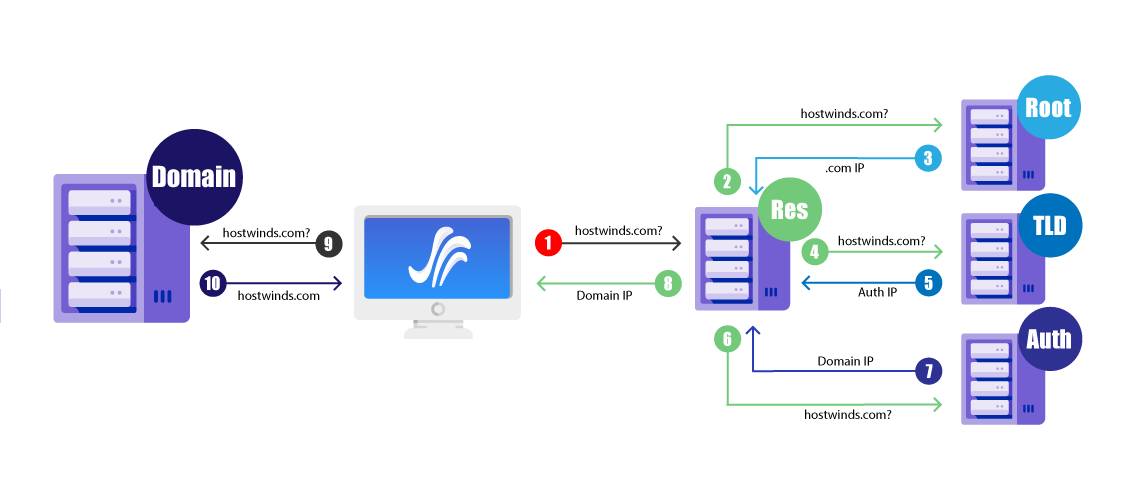Hostwinds Blog
Search results for:

What is DNS (Domain Name System) and How Does it Work?
by: Hostwinds Team / July 25, 2023
If you've ever set up a website or managed a domain name, you've probably come across the term DNS. DNS, short for the Domain Name System, is an essential component of how the internet functions.
Whether you're a website owner, an aspiring web developer, or simply curious about the intricacies of internet connectivity, this blog post will equip you with a deep understanding of DNS and its pivotal role in maintaining a well-connected digital world.
So, let's jump into this fascinating realm where domain names translate into IP addresses and unravel the framework that makes the internet function.
What is DNS?
At its core, DNS is a hierarchical naming system that translates human-readable domain names, like hostwinds.com, into computer-readable IP addresses, such as 104.168.205.10. When you enter a domain name into your web browser, your computer sends a request to a DNS resolver, which then queries the DNS server hierarchy to find the corresponding IP address.
DNS Name Servers
The DNS hierarchy consists of four main levels of DNS servers, also known as name servers. Each of these servers plays a specific role in fulfilling DNS queries or lookups. Let's take a closer look at these name servers.
DNS Resolver
Also referred to as a recursor, the DNS resolver is a server typically operated by your internet service provider (ISP). It communicates with other name servers to help find and retrieve the requested information, such as a web page.
Root Nameserver
Root name servers store information about the location of top-level domain (TLD) servers. They guide the resolver to the TLD server housing information on the requested domain's domain extension.
TLD (Top-level Domain) Server
TLD servers contain information specific to domain extensions (.com, .net, .org, etc.) and are categorized into three main types:
- gTLDs (Generic Top-Level Domains) - General purpose domain extensions, including ".com," ".net," and ".org."
- ccTLDs (Count Code Top-Level Domains) - Country or territory specific domain extensions, like ".uk," ".ca," and ".jp"
- sTLDs (Sponsored Top-Level Domains) - Specialized domain extensions tied to specific interests or communities, like ".gov," ".edu," and ".aero."
These servers guide the resolver to the authoritative server.
Authoritative Nameserver
Authoritative nameservers store the IP addresses of domain names. They contain the information that the resolver uses to tell a browser where it can find the domain of the website it's trying to connect to.
How DNS Lookup Works
Now that we have a basic understanding of nameservers in the domain name system, let's walk through the process of how they collaborate to fulfill a client query through DNS lookup.
1. User Performs Query
The user triggers a DNS query by typing in or clicking on a URL (e.g., hostwinds.com/blog) in a web browser (Safari, Chrome, Firefox, etc.). This query, or website URL, is sent to the DNS resolver which sets out to find the IP address of the domain hosting the website.
2. Resolver Contacts Root Nameserver
The resolver starts by contacting the root nameserver, asking where it can find the Top-Level Domain (TLD) server that handles the category of TLDs matching the domain's extension (e.g., ".com" for "hostwinds.com").
3. Resolver Contacts TLD Server
The resolver reaches the TLD server, requesting the location of the authoritative name server responsible for the appropriate domain extension. The TLD server responds with the authoritative nameserver's IP address.
4. Resolver Contacts Authoritative Nameserver
The resolver locates the appropriate authoritative nameserver and requests the IP address of the website's domain. The authoritative nameserver finds the domain's IP address and sends it to the resolver.
5. Resolver Responds to Browser
The resolver hands the domain IP address off to the browser so it can finalize the user query.
6. Browser Fulfills User Query
The browser uses the domain IP to locate the web server hosting the website and establishes a connection via an HTTP request. The web server locates the requested content (e.g. hostwinds.com/blog) and sends it to the browser where it is rendered on the user's device (phone, laptop, tablet, etc.).

DNS Record Types
DNS records are used to store information about domain names and their associated IP addresses. There are several different types of DNS records, each with its specific purpose. Here's an overview of some of the most commonly used DNS record types:
A Record: Short for Address Record, the A Record maps a domain name to an IP address (e.g., example.com -> 192.0.2.1).
Think of the A Record as being similar to your phone's contact list where Jane, John, and Jerry have a specific number associated to each of their names. Similar to how you tap Jane's name to call her number, the DNS system taps the A record to call the IP address of a domain name.
CNAME Record: Also known as "Canonical Name", CNAME Record is used to redirect an alias domain, typically a subdomain (e.g. www.hostwinds.com) to a canonical domain, also known as the primary or root domain (e.g. hostwinds.com). When a DNS query encounters a CNAME record, it will follow the alias (www.hostwinds.com) to the IP address of the canonical domain name (hostwinds.com).
MX Record: The Mail Exchange Record specifies the mail server(s) responsible for receiving email on behalf of a domain. For instance, if the MX record for "example.com" points to "mail.example.com," emails sent to addresses like "user@example.com" are directed to the "mail.example.com" mail server.
TXT Record: The TXT record is used to store arbitrary text data associated with a domain name. It's often used for domain verification or to store SPF or DKIM records for email authentication.
Common DNS Issues and Troubleshooting
While DNS is a critical part of how the internet works, it's not without its issues. Here are some common DNS issues and how to troubleshoot them:
DNS propagation delays: When you change the DNS records for a domain, it can take some time for the changes to propagate to all DNS servers around the world. This can lead to temporary connectivity issues for some users. The best way to deal with this issue is to wait for the changes to propagate fully.
DNS cache issues: DNS resolvers and browsers cache DNS records to improve performance. However, this can sometimes lead to issues if the cached records become outdated. To troubleshoot this issue, you can try clearing your DNS cache or flushing your browser cache.
DNSSEC configuration issues: DNSSEC is a security protocol that adds an extra layer of authentication to DNS queries. However, it can sometimes be misconfigured, leading to DNS resolution issues. To troubleshoot this issue, you can use a DNSSEC validation tool to check your DNSSEC configuration.
Best Practices for Managing DNS
Proper DNS management will ensure the seamless functioning and accessibility of your website. With the right approach, you can significantly enhance reliability, performance, and overall user experience. Here are a few best practices to follow when managing DNS:
Choose a Reliable DNS Provider: The foundation of effective DNS management begins with selecting a reputable DNS provider. Look for providers with a proven track record of high uptime and fast response times. A reliable DNS provider ensures that your website's domain resolution remains consistently available and responsive to user requests.
Implement DNS Redundancy for High Availability: Embrace the principle of redundancy by deploying multiple DNS servers. This redundancy strategy ensures that if one server experiences downtime or encounters issues, the others can seamlessly handle DNS queries. Particularly vital for high-traffic websites or those with mission-critical functions, DNS redundancy mitigates the risk of service disruptions.
Configure DNS for Optimal Website Performance: DNS plays a significant role in determining website performance. Choose a DNS provider that offers advanced features such as geolocation-based routing. This enables directing users to the nearest server based on their geographical location, reducing latency and enhancing website speed. Additionally, leverage DNS caching to store frequently requested DNS records, minimizing lookup times and improving overall reliability.
DNS Makes the World Wide Web Go Round
DNS serves as the backbone of the internet, ensuring that our digital world remains interconnected and accessible. With its collaborative name servers, DNS efficiently translates human-readable domain names into computer-friendly IP addresses, enabling smooth navigation across the vast web landscape. This introduction offers a foundation that will assist you in learning more about DNS management and deliver seamless user experiences.
Related Articles:
Written by Hostwinds Team / July 25, 2023
